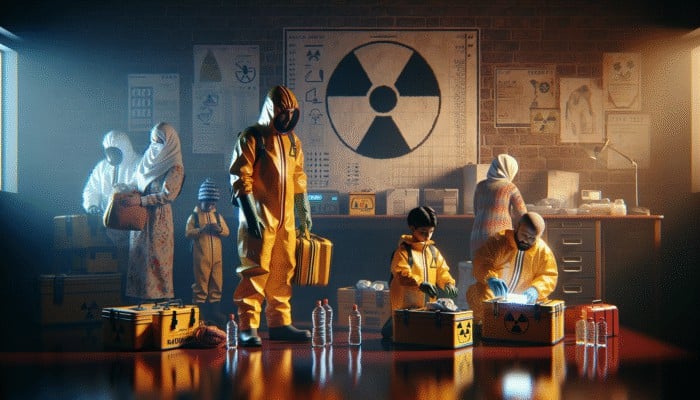Essential Steps for Preparing for a Nuclear Event
Building an Essential Stockpile of Supplies
 A robust survival strategy requires meticulous preparation, particularly when considering nuclear survival tips. Begin by compiling a well-rounded emergency kit containing non-perishable food items, clean drinking water, and vital medical supplies. Aim for a minimum of two weeks' worth of provisions for each member of your household, as accessibility to resources may be severely impeded following a nuclear incident. Opt for high-calorie, lightweight food options such as energy bars, canned goods, and dehydrated meals to maximise sustenance without adding excessive weight.
A robust survival strategy requires meticulous preparation, particularly when considering nuclear survival tips. Begin by compiling a well-rounded emergency kit containing non-perishable food items, clean drinking water, and vital medical supplies. Aim for a minimum of two weeks' worth of provisions for each member of your household, as accessibility to resources may be severely impeded following a nuclear incident. Opt for high-calorie, lightweight food options such as energy bars, canned goods, and dehydrated meals to maximise sustenance without adding excessive weight.
Water is a critical necessity; experts suggest storing at least one gallon per person per day. Use robust, food-grade containers for storage, and remember to include purification tablets or filters for additional safety. Your medical supplies should include first aid kits, necessary prescriptions, and over-the-counter medications. Also, don’t overlook hygiene essentials such as soap, hand sanitiser, and toilet paper, as cleanliness will be paramount in emergencies.
When selecting your supplies, consider your local climate. If you live in a warmer area, heat-stable food options become essential, while those in colder climates may need insulation materials to prevent supplies from freezing. Furthermore, a dependable flashlight, batteries, and a radio are crucial for staying informed during emergencies and ensuring you remain updated on developments.
Lastly, maintain an inventory of your supplies, updating it regularly. This practice is vital to ensuring you have all necessary items when they matter most, allowing for a swift response in times of crisis.
Constructing a Safe Shelter
Your immediate safety during a nuclear incident relies heavily on locating or constructing a protective shelter. Fundamental nuclear survival tips advocate using materials that can effectively block harmful radiation. Without a dedicated shelter, a well-stocked basement, an interior room devoid of windows, or even a sturdy vehicle, a person can be a temporary refuge from potential harm.
Employing concrete, brick, or earth as shielding can significantly diminish radiation exposure. Should you create a makeshift shelter, ensure that windows and doors are covered with heavy blankets or tarps to minimise contamination risk. Additionally, constructing a simple earth berm around your shelter can further enhance your safety and protection from external threats.
Before any emergency occurs, familiarise yourself with your surroundings to pinpoint potential shelter locations. Community centres, schools, or designated fallout shelters may provide refuge during critical times. Remember that location is key; a structure featuring a solid roof and no windows is preferable for maximum safety.
Ensure that your chosen shelter has adequate ventilation to prevent suffocation. If time allows, consider constructing a basic air filtration system using commercially available filters or DIY methods. Preparing your shelter is not merely prudent; it’s essential for ensuring your survival during a crisis.
Formulating a Comprehensive Evacuation Plan
A well-structured evacuation plan is a vital component of your nuclear survival tips. Your strategy should encompass multiple escape routes from your current location, considering potential barriers such as traffic congestion or road blockages. Familiarise yourself with alternative paths to evade being caught in a bottleneck situation during an emergency.
Designate specific meeting points for family members in the event of separation. These locations should be in safe zones, distanced from the initial threat, and easily accessible. Ensure that everyone is well-versed in the evacuation protocol, including what items to bring along and how to maintain communication throughout the emergency.
It is advisable to practice your evacuation plan with family members. Conduct drills that mimic the urgency of needing to leave quickly and provide training on navigating your predetermined routes. Having a portable communication device on hand will help maintain contact while moving.
Building relationships with your neighbours can significantly enhance your evacuation plan. Sharing resources and strategies will empower everyone in your community, making it easier to evacuate collectively. Remember, preparedness is not solely about individual safety; it involves fostering collective resilience and support.
Comprehending Nuclear Threats
Identifying Various Types of Nuclear Incidents Understanding the various types of nuclear incidents is crucial for effective preparedness. Nuclear threats can originate from accidents, such as reactor meltdowns, or intentional acts like nuclear war. A scenario that presents unique challenges and necessitates distinct responses, making it vital to familiarise yourself with these possibilities as part of your nuclear survival tips.
Accidental nuclear events, akin to those witnessed in Chernobyl and Fukushima, generally arise from human error, equipment malfunction, or natural disasters. These incidents can result in widespread contamination, necessitating immediate evacuation and long-term safety measures. In these situations, understanding prevailing wind patterns can assist in assessing which areas might be adversely affected.
Conversely, intentional nuclear strikes can induce widespread panic and chaos. Knowing how to respond rapidly is essential. Familiarise yourself with local alert systems and warning protocols, as these can save lives by delivering timely information to those at risk.
Furthermore, it is crucial to understand the distinctions between a nuclear explosion and a radiological dispersal device, commonly referred to as a “dirty bomb. ” While the former inflicts instantaneous, catastrophic damage, the latter involves dispersing radioactive material without a nuclear detonation. Each type of incident requires tailored preparedness strategies, underscoring the need for comprehensive planning.
Evaluating Radiation Exposure Risks
The risks associated with radiation exposure during and after a nuclear event can be severe and enduring. One of the key nuclear survival tips involves understanding how to minimize exposure effectively. Radiation can inflict immediate harm; however, the long-term health implications can be even more daunting and complex. Radiation exposuren can lead to acute radiation syndrome (ARS), which is characterised by symptoms such as nausea, vomiting, and extreme fatigue. Prolonged exposure increases the likelihood of developing cancer and other serious health conditions. Recognising the symptoms of ARS is critical for early intervention, as prompt medical attention can significantly enhance recovery outcomes.
To decrease your risk of radiation exposure, it is imperative to remain indoors in a well-sealed shelter until authorities declare it safe to exit. Avoid consuming contaminated food and water; instead, stick to sealed or packaged items that have been stored away from potential fallout.
Monitoring radiation levels is equally important. Invest in a reliable Geiger counter or radiation detector, as these devices can offer real-time information regarding the safety of your environment. Understanding how to interpret these readings will empower you to make informed decisions concerning your safety and health.
Recognising Long-Term Effects of Nuclear Incidents
The long-term consequences of nuclear incidents can be catastrophic, impacting not only physical health but also environmental stability. As part of your nuclear survival tips, it is essential to recognise these impacts to establish a comprehensive recovery strategy.
On the health front, survivors may face heightened risks of thyroid cancer, leukemia, and other radiation-induced illnesses. Awareness of these risks allows individuals to prepare better and explore viable treatment options. Regular medical check-ups and screenings are crucial for those who have been exposed to harmful radiation.
Beyond individual health concerns, nuclear contamination can inflict significant ecological damage. Contaminated soil and water sources can disrupt agricultural practices, ultimately threatening food security and local economies. Engaging with environmental recovery initiatives is vital for restoring affected areas and ensuring safe food production in the future.
Local communities have a pivotal role in fostering resilience by creating educational programmes that underscore the importance of environmental stewardship following an incident. By understanding the long-term consequences, individuals and communities can collaboratively develop strategies that promote recovery and rehabilitation in the wake of nuclear threats.
Immediate Actions You Should Take During a Nuclear Event
 Prioritising Immediate Shelter
Prioritising Immediate Shelter
Your first instinct during a nuclear incident should be to seek immediate shelter. This is one of the most critical nuclear survival tips you can adhere to. Act swiftly when you receive a warning, whether through an official alert system or from personal communication. The objective is to minimise your exposure to radiation by seeking refuge indoors as quickly as possible.
If you find yourself outdoors when the event occurs, locate the nearest building or structure. Ideally, this should be a basement or an interior room devoid of windows. The more physical barriers you have between yourself and the external environment, the better your chances of safety will be.
If you are already indoors, remain there and seal off the space by closing all doors and windows. Employ duct tape and plastic sheeting to create an airtight barrier, which will help keep radioactive particles out, thus significantly reducing your risk of contamination.
While in your shelter, gather necessary supplies and strive to remain calm. Panic can lead to hasty decisions, which can further jeopardise your safety. Stay tuned to emergency broadcasts for information on the unfolding situation, as authorities will provide updates on when it is safe to exit your shelter.
Utilising Protective Gear Effectively
Wearing protective gear can drastically reduce your risk of radiation exposure during a nuclear event, making it a vital component of your nuclear survival tips. If time permits, don long-sleeved clothing and sturdy footwear to cover as much skin as possible, creating a barrier against potential contaminants.
Masks and respirators are essential for filtering out radioactive particles from the air. If you lack access to specialised masks, a damp cloth can serve as a temporary measure, assisting in trapping dust and particles that may pose a risk.
Remember to protect your hair if you find yourself in a contaminated area. A simple cap or scarf can prevent radioactive dust from settling onto your scalp. Additionally, consider wearing gloves to protect your hands from contamination when handling objects outside your shelter.
Once you arrive at a safe location, remove any outer clothing that may have been exposed to radiation. Place these items in a sealed plastic bag to prevent further contamination. Bathe thoroughly as soon as it is safe, using soap and water to wash away any residual particles that could pose a health risk.
Constantly Monitoring Radiation Levels
Continuous monitoring of radiation levels is imperative during a nuclear incident. This knowledge allows you to make informed decisions regarding your safety and is among the most effective nuclear survival tips. Invest in a Geiger counter or radiation detector that provides real-time updates on radiation levels in your environment.
Understanding how to interpret readings from these devices is crucial. Familiarise yourself with the safe thresholds for radiation exposure as defined by health authorities. If radiation levels are elevated, remain in your shelter until you receive confirmation that leaving is safe.
Additionally, pay attention to local emergency broadcasts. Authorities will deliver updates on radiation levels and guidelines concerning when and where it is safe to evacuate. Building a community network can also enhance your ability to stay informed, as neighbours can share vital information and resources during such critical times.
Developing connections with local emergency management services can also provide insights into monitoring radiation levels and specific safety protocols pertinent to your area. Always remember that knowledge is power when it comes to survival.
Adhering to Emergency Protocols
Following local emergency protocols is paramount during a nuclear event. These protocols are meticulously crafted to safeguard public safety and are among the most essential nuclear survival tips you can follow. Familiarise yourself with your local emergency management plans well before any incident.
Authorities will typically provide guidelines on what to do during a nuclear event. These may include specific instructions regarding sheltering in place, evacuating, or accessing medical care. Following these directives can significantly enhance one's chances of remaining safe during the crisis.
Stay vigilant for emergency alerts disseminated through various channels, including radio, television, and mobile notifications. These alerts will deliver critical information regarding safe evacuation routes, shelter locations, and vital safety measures.
Engaging with your community can also bolster your response efforts. Encourage discussions about emergency protocols among friends, family, and neighbours. This collective awareness fosters a supportive environment where everyone understands their roles in maintaining safety during a crisis.
Post-Event Survival Strategies for Recovery

Avoid consuming any food or water that may be contaminated. Stick to sealed supplies that you stored before the event. If you have concerns about your water source, consider using purification tablets or boiling water before consumption to ensure safety.
Moreover, if you contact individuals who may have been exposed, ensure they follow decontamination procedures as well. This collective approach minimises the risk of spreading contamination and promotes community safety during a critical time.
Strategic Management of Resources
Resource management becomes crucial in the aftermath of a nuclear incident. One of the most effective nuclear survival tips involves rationing your supplies judiciously to prolong their availability. Begin by assessing your resources and formulating a distribution plan among family members.
Start with food and water, prioritising high-energy options to maintain strength and morale during recovery. If access to fresh water is limited, consider conservation techniques such as reusing water for cooking or minimal hygiene practices to stretch your supplies further.
If deemed secure, explore alternative food and water sources, such as foraging for safe edible plants or collecting rainwater. However, exercise caution regarding potential contamination in natural resources.
Remember that resource management is not solely about survival; it’s also about maintaining morale. Engage family members in discussions regarding plans and strategies. This collaborative effort can foster community and resilience, vital during challenging times.
Establishing Effective Communication Channels
Clear communication channels are essential for survival during the recovery period. One key nuclear survival tip involves setting up a robust communication plan to stay informed and connected with others. Utilize various methods, including text messages, social media, or radio broadcasts, to ensure you can reach family members and neighbours.
Designate a primary point of contact for family members to check in with, ensuring everyone knows where to find updates. If feasible, establish a specific meeting spot in case communication fails, providing a clear plan for reuniting if separation occurs.
Utilise community bulletin boards or local emergency services for updates on the situation. Many communities have established systems for disseminating critical information during a crisis. Engaging with local groups can also open doors to resources and support systems during recovery.
Don’t underestimate the power of face-to-face communication. Engaging with your neighbours fosters a robust community network, providing emotional support and exchanging information as you navigate the aftermath of a nuclear event together.
Health and Medical Considerations in the Aftermath
Appropriate Treatment for Radiation Sickness
Understanding how to treat radiation sickness is essential for improving recovery outcomes. This is one of the most actionable nuclear survival tips to consider. Symptoms can range from mild nausea and vomiting to severe effects like loss of consciousness, depending on the level of exposure.
If you suspect that you have been exposed to radiation, seek medical attention without delay. Medical professionals will typically administer treatments such as potassium iodide, which effectively blocks radioactive iodine uptake by the thyroid gland.
Staying hydrated is crucial, as fluids can alleviate some symptoms of radiation sickness. Consume electrolyte solutions to maintain balance and support your body during recovery whenever possible. Rest is equally important; your body will require energy to combat radiation exposure's effects effectively.
Moreover, remain vigilant about developing symptoms, as they can vary widely. Proactively seeking medical assistance can enhance the effectiveness of treatment and facilitate recovery, emphasising the importance of timely intervention.
Prioritising Mental Health During Recovery
Mental health frequently goes overlooked following a nuclear event, yet it is just as vital as physical health. Prioritising mental well-being involves staying calm and practising stress-relief techniques. This is one of the essential nuclear survival tips that can help you and your family cope with trauma during recovery.
Engage in mindfulness exercises, such as deep breathing or meditation, to manage anxiety effectively. Staying informed through reliable sources can instill a sense of control and alleviate fear of the unknown. Open conversations with loved ones allow for expressing feelings and concerns and foster emotional support and resilience.
Consider reaching out to mental health professionals for guidance during the recovery period. Many organisations may offer services specifically tailored to those affected by nuclear events. Don’t hesitate to seek help; addressing mental health is crucial for your overall recovery and well-being.
Building resilience through community involvement can greatly enhance mental well-being. Participating in group activities or support networks encourages connection, providing comfort in shared experiences during challenging times.
Accessing Medical Care Effectively
Accessing medical care post-incident is vital for your health and recovery. In the aftermath of a nuclear event, medical facilities may become overwhelmed with patients. Familiarise yourself with local hospitals and clinics in advance as part of your nuclear survival tips.
Maintain a list of essential medical contacts, including primary care physicians and mental health services. Should you have pre-existing conditions, ensure you have an ample supply of medications, as pharmacies may struggle to restock during recovery efforts.
Stay informed about the operational status of medical facilities through community networks or emergency broadcasts. If a facility becomes overwhelmed, be prepared to seek alternative options. Community health initiatives may provide essential services during the aftermath of a disaster.
Consider volunteering to assist local health organisations during the recovery process. This not only aids your community but can also offer valuable training in emergency response and medical care, enhancing your preparedness for future incidents.
Strategies for Long-term Recovery and Rehabilitation
Reconstructing Vital Infrastructure
Reconstruction of essential infrastructure plays a critical role in community recovery following a nuclear event. It is one of the most significant nuclear survival tips for long-term resilience. Communities must prioritise rebuilding public facilities, including hospitals, schools, and transportation systems, to restore normalcy and functionality.
Involve community members in planning to ensure that the reconstruction meets local needs and requirements. This collaborative approach fosters a sense of ownership and investment in recovery, empowering residents to rebuild actively.
Consider leveraging technology and resources to create a more resilient infrastructure. Implementing sustainable practices ensures that the new systems are functional and adaptable to future challenges and disasters.
Engage with local governments and agencies to secure funding and support for infrastructure projects. Developing a detailed recovery plan can streamline efforts and provide clear objectives for moving forward, ensuring all community members are on the same page.
Community resilience heavily depends on strong infrastructure; therefore, prioritising these efforts can significantly enhance recovery initiatives and promote long-term sustainability within the community.
Conducting Environmental Cleanup Initiatives
Participating in environmental cleanup efforts is essential for reducing long-term radiation risks. This aspect of nuclear survival tips is crucial for promoting health and safety in affected communities. Engaging in decontamination projects can help restore ecosystems and protect public health, allowing for a more rapid recovery.
Collaborate with local governments and environmental organisations to identify contaminated areas that require immediate attention. Participating in organized cleanup initiatives not only aids recovery but also fosters community engagement and solidarity, reinforcing social ties in times of crisis.
Educate yourself and others about safe cleanup practices. Understanding how to handle potentially contaminated materials is vital for ensuring individual and public safety during these efforts.
Encouraging community involvement in environmental initiatives can raise awareness of nuclear safety and preparedness. The more individuals understand the associated risks and cleanup methods, the better equipped they will be to respond effectively in the future.
Establishing Robust Community Support Systems
Building strong community networks is paramount for providing mutual aid and support during recovery. One of the most important nuclear survival tips emphasises the strength found in unity. Collaborating with neighbours enhances information sharing, resource management, and emotional support, creating a safer environment for all.
Establish local support groups to address various needs, including mental health care and resource distribution. Encourage participation in community planning sessions to draw on diverse perspectives and expertise, ensuring that all voices are heard during recovery efforts.
Create local directories listing available resources, such as food banks, medical assistance, and counselling services. This transparency will facilitate easier access to support and encourage community members to help one another during difficult times.
Building strong community systems enhances resilience and ensures everyone has access to the assistance they require during recovery. In times of crisis, unity can be a powerful tool for fostering healing, rebuilding, and thriving together.
Prioritising Access to Mental Health Services
Establishing mental health services to address psychological trauma is crucial for promoting overall well-being in affected populations. This is a key aspect of nuclear survival tips that often goes unnoticed. Create initiatives that focus on counselling, stress management, and community engagement, thus addressing the community's mental health needs.
Mental health professionals should be involved in providing essential support and training for community members. Hosting workshops and support groups can foster open discussions regarding trauma and collective healing, enabling individuals to cope with their experiences effectively.
Encourage community members to share their experiences and feelings openly. Creating a safe space for dialogue can significantly enhance emotional resilience and promote healing in the aftermath of traumatic events.
Collaborating with local organisations and schools to implement mental health programmes ensures that individuals receive the necessary support in the aftermath of a nuclear event. Prioritising mental health is as important as addressing physical recovery, reinforcing that holistic care is vital for community well-being.
Revitalising the Local Economy
Economic revitalisation is essential for long-term recovery and sustainability following a nuclear incident. Implement strategies that stimulate local economies, create jobs, and support businesses during recovery as part of your nuclear survival tips.
Engage local leaders in discussions about rebuilding economic structures and systems. Consider offering incentives for businesses to return to the area or to start anew, which can encourage investment and job creation, both of which are vital for community recovery.
Explore opportunities for diversifying economic activities within the region to bolster resilience against future disasters. Encourage community engagement in local markets and businesses to foster a sense of ownership and connection among residents.
Training programmes for job skills and entrepreneurship can empower individuals, thus creating a robust and capable workforce. Investing in education and skills development ensures community members can thrive in a post-disaster environment.
A strong, sustainable economy is fundamental to recovery and resilience. By prioritising economic revitalisation, communities can create pathways for growth and stability, enabling a brighter future for all residents.
Advocating for Education and Awareness
Learning from Historical Nuclear Incidents
Studying historical nuclear events is vital for understanding their impacts and improving future responses. This is one of the most enriching nuclear survival tips you can adopt. Analyse the responses to incidents like Chernobyl, Fukushima, and Hiroshima to identify effective strategies and lessons learned.
Understanding these events' social, environmental, and psychological ramifications can guide your preparedness strategies. Engage with experts in the field and participate in workshops or seminars focusing on nuclear safety and effective response actions.
Sharing knowledge with your community enhances collective preparedness. Consider organising community discussions or informational sessions to raise awareness of nuclear risks and safety measures, empowering individuals to take proactive steps.
Promote initiatives that encourage a culture of safety and education concerning nuclear preparedness. The more informed a population is, the better equipped they will be to respond effectively to nuclear threats and incidents in the future.
Implementing Awareness Campaigns
Awareness campaigns can significantly enhance community preparedness for nuclear events. Developing educational materials, workshops, and public discussions represents a proactive approach to ensuring everyone understands the risks and responses associated with nuclear threats.
Utilise various media channels, including social platforms, newsletters, and community bulletins, to disseminate information regarding safety protocols and emergency procedures. Engage local schools, businesses, and organisations in effectively spreading knowledge about nuclear preparedness.
Consider collaborating with experts to develop comprehensive curricula that cover radiation safety, emergency response, and mental health awareness. Such programmes empower individuals and families, fostering a culture of preparedness within communities.
Evaluate the effectiveness of your campaigns regularly and adapt them based on community feedback. Continuous improvement ensures that the materials resonate with the audience and address their concerns, ultimately enhancing overall preparedness.
Promoting Community Resilience Initiatives
Fostering a culture of resilience is crucial for enhancing community preparedness for nuclear events. This can involve creating initiatives that focus on building social connections, trust, and collaboration among community members, which are vital in times of crisis.
Encourage participation in local groups or organisations focused on emergency preparedness, mental health, and resource management. The more connected individuals are, the easier it will be to mobilise resources and support each other during an emergency.
Consider organising training sessions that teach community members essential survival skills, such as first aid, basic firefighting, and effective communication strategies. These skills empower individuals and families to respond effectively in adversity, enhancing community preparedness.
Building a culture of resilience is not solely about survival; it’s about thriving in the aftermath of a crisis. By fostering strong community ties and support networks, you can ensure that everyone is better equipped to face potential nuclear threats together.
Frequently Asked Questions
What should I include in my nuclear emergency kit?
Your nuclear emergency kit should contain non-perishable food, clean drinking water, a comprehensive first-aid kit, personal hygiene items, protective gear, a reliable flashlight, batteries, and a radio for updates.
How can I create a shelter from radiation?
To create a shelter, locate or build a space with thick walls, ideally underground or in a basement. Use heavy materials such as concrete or earth to shield against radiation, and ensure that windows and doors are well-sealed.
What are the immediate steps during a nuclear event?
Seek immediate shelter, cover windows and doors to prevent contamination, monitor emergency broadcasts for updates, and remain indoors until authorities declare it safe to exit your shelter.
How can I treat radiation sickness?
Seek medical attention immediately if you suspect radiation exposure. Stay hydrated, rest, and inform health professionals of your symptoms to receive the best treatment options.
What are the long-term health risks after exposure?
Long-term risks include an increased likelihood of developing cancer, particularly thyroid cancer and leukemia, as well as other radiation-induced illnesses, highlighting the importance of medical follow-ups for those exposed.
How can I manage resources after a nuclear event?
Carefully ration your supplies and explore alternative food and water sources, ensuring that your resources last as long as possible during recovery following the event.
What role does mental health play in nuclear survival?
Mental health is crucial for coping with trauma and stress caused by nuclear events. Support systems, counselling, and community engagement can promote emotional resilience during recovery, ensuring individuals can heal effectively.
How can communities rebuild after a nuclear incident?
Communities can rebuild by restoring vital infrastructure, engaging in environmental cleanup, fostering economic revitalisation, and establishing strong support networks for residents affected by the incident.
What educational resources are available for nuclear preparedness?
Many organisations provide educational materials, training programmes, and nuclear safety and preparedness workshops. For additional resources and information, contact local emergency management services.
How can I involve my community in preparedness efforts?
Encourage participation in local meetings, educational campaigns, and training sessions centred on nuclear preparedness to build awareness and foster collaboration among community members, enhancing collective resilience.
Explore our journey on X!
Emergency Radio Picks: Your Universal Survival Guide
Comprehensive Guide to Emergency Radio Picks: Stay Informed During Crises What Are Emergency Radio Picks and Their Significance? Emergency Radio Picks: These devices are meticulously engineered to receive important broadcasts during crises, ensuring that individuals remain updated when standard communication channels fail. These radios are indispensable tools that provide vital information about weather emergencies, natural disasters, […]
Surviving a City Blackout: Essential Tips
Essential Steps for Blackout Preparedness Gathering Crucial Emergency Supplies Surviving a City Blackout: Being proactive in your preparation for a blackout is absolutely vital. Remember that power outages can occur unexpectedly and may last for several days, impacting your daily life significantly. It is prudent to ensure you have enough essential supplies to manage this […]
Grid-Down Heating: Essential Strategies
Exploring Effective Strategies for Heating During Power Outages What Is Grid-Down Heating and How Does It Work? Grid-Down Heating: Grid-down heating encompasses a range of innovative and traditional heating solutions that are employed when the electrical grid is incapacitated due to power outages. In these circumstances, reliance on conventional heating systems becomes impractical, prompting the need […]
Protecting Valuables in Crisis: Universal Strategies
Crucial Steps for Effective Crisis Preparedness Developing a Comprehensive Crisis Response Strategy Protecting Valuables in Crisis: Creating a thorough crisis response strategy is vital for effectively safeguarding your valuables during any unforeseen crisis. This strategy should encompass essential elements such as a list of emergency contacts, designated safe locations, and clear, actionable procedures for protecting […]








I find it really interesting that you emphasize the importance of stocking up on non-perishable food and clean water. It’s one of those things that often gets overlooked until it’s too late. I’ve started to build my own emergency kit, but it’s more challenging than I thought! Finding foods that not only have a long shelf-life but are also palatable is tricky.
This post brings up such a vital topic that many people may overlook—preparation for nuclear events isn’t just about the supplies, but also about mindset and community. I appreciate your emphasis on a well-rounded emergency kit. It makes me think about how we often prepare only for the more common emergencies while neglecting scenarios that feel distant or improbable.
I really appreciate your thoughtful outline on preparing for a nuclear event. It’s a topic that, while difficult to think about, is increasingly relevant in today’s world, especially with the rising geopolitical tensions and environmental concerns that seem to be in the news more frequently.
Your insights on preparing for a nuclear event are incredibly important, especially in today’s unpredictable world. The emphasis on having a two-week stockpile is crucial; it reminds me of the wider conversation around emergency preparedness in general. It’s interesting to think about how natural disasters have often served as a wake-up call for many families to get better organized, and a nuclear event highlights the need for awareness across the board.
I’m all for stockpiling food and water, but let’s be honest—if a nuclear event happens, I might just be hoarding a lifetime supply of peanut butter and jelly instead of the serious stuff! I mean, nothing says “surbruvival” quite like a classic PB&J! Plus, it’s the perfect comfort food while hunkering down.
Your insights on preparing for a nuclear event really prompt deeper reflection on the intersection of personal safety and societal responsibility. In our increasingly unpredictable world, it’s easy to overlook the importance of preparedness. I found your emphasis on building a comprehensive stockpile particularly valuable; having supplies ready not only offers peace of mind but also enables individuals to support their community in times of crisis.
Your insights on preparing for a nuclear event touch on a critical aspect of survival that is often overlooked in today’s fast-paced world. As we navigate our lives surrounded by technological advances, it’s remarkable how preparedness for emergencies—like a nuclear incident—forces us to reflect on our vulnerability and reliance on systems that often feel infallible.
I appreciate the emphasis on building a comprehensive stockpile for nuclear preparedness. However, I wonder about the psychological aspects of preparing for such an event. While having a well-rounded emergency kit is essential, it’s equally important to consider mental resilience in the face of a nuclear incident. The uncertainty and fear associated with such disasters can be overwhelming.
The steps outlined for preparing for a nuclear event are indeed critical and often overlooked in common disaster preparedness discussions. Personally, I’ve found that thinking through these scenarios not only helps in creating a practical stockpile but also fosters a sense of security. It’s interesting how the concept of emergency preparedness often intersects with broader themes of resilience and community.
Your insights on preparing for a nuclear event highlight the critical importance of thorough readiness in our increasingly uncertain world. As daunting as the prospect of a nuclear incident may be, the reality is that comprehensive emergency planning can provide a sense of security and agency in the face of potential calamity. The emphasis on building an essential stockpile aligns well with long-established principles in disaster preparedness, which often advocate for households to be self-sufficient for a significant period, particularly in the wake of a catastrophe when access to basic supplies might be compromised.